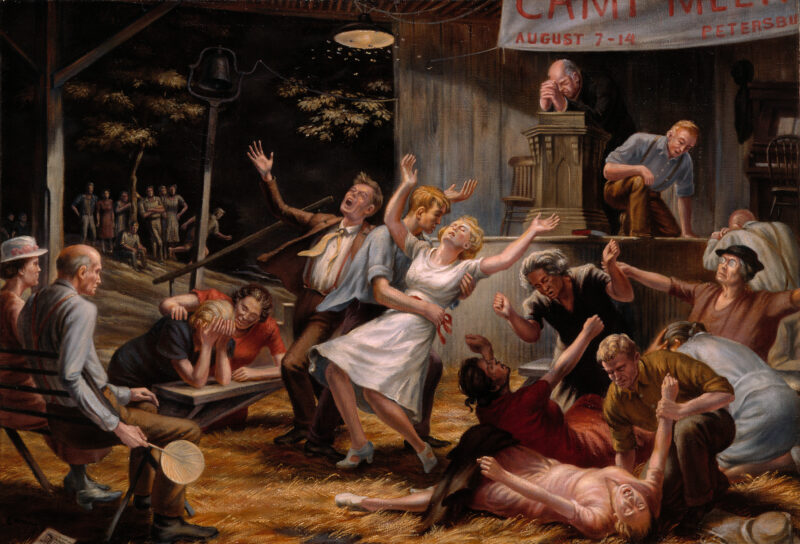
Camp Meeting
Laning, Edward
1937
Artwork Information
-
Title:
Camp Meeting
-
Artist:
Laning, Edward
-
Artist Bio:
American, 1906–1981
-
Date:
1937
-
Medium:
Oil on canvas
-
Dimensions:
33 x 48 inches
-
Credit Line:
Wichita Art Museum, Museum purchase, Friends of the Wichita Art Museum, Gift Shop Art Fund
-
Object Number:
1981.10
-
Display:
Not Currently on Display
About the Artwork
Edward Laning was a noted painter and teacher, active primarily from the 1930s through the 1950s. He worked in a figurative style that he employed in both historic narrative and satiric social commentary, including a series relating the exploits of the radical Midwestern campaigner for prohibition, Carry Nation. Laning distinguished himself in the execution of numerous public murals in New York City during the 1930s and 1940s, with the Ellis Island moral, The Role of the Immigrant in the Industrial Development of America, 1937, being of special note.
Amid the Camp Meeting’s theatrically lit scene of a communal orgy of emotion unfolding upon the grounds of a midsummer’s night’s tent revival meeting, a scrap of paper flutters to rest in a shadowed lower left corner offering up the epitaph “The Scarlet Sin, Adultery!” Looking at this event one might well ask, “Is this an accusation or a siren call to arms?” Painter and muralist Edward Laning hinted at his assessment not only in the swooning faints of the country damsels and the dishevelment of their swains, but in the sly analogy of the narrative event to the detail of the moths swarming about a single metal-shaded light bulb hanging above the scene.
Many contemporary critics of the Regionalists as well as historians have remarked that the well-educated, urbane painters of the Regionalist school often tread a thin line between description and caricature in their depictions of the rural cultures and locales of their childhoods. The fact that Laning cast his comic drama in his own hometown of Petersberg, Illinois, as is implied in the place name on the banner in the painting’s upper right corner, suggests that there may have been an element of personal resentment in this characterization of small town culture. Moreover, the theme of the revival meeting appealed to the critical disposition of the Depression era social realists, writers or painters, who chafed at hypocrisy and narrowness, particularly in matters of sex.
The carefully positioned groups of “actors” visible in the composition of Camp Meeting speaks admirably to Laning’s training with teachers Thomas Hart Benton and Kenneth Hays Miller and to his special strength as a muralist. Laning learned how to think in terms of sculptural figures moving in the round from both Benton, himself a leading muralist, and from Hays who emphasized the emulation of Renaissance compositions of multi-figure pageantry. In Camp Meeting Laning composed individual vignettes of two or more carefully modeled figures to illustrate a spectrum of emotion from supplication, sympathetic identification, despair, prostration, ecstatic trance, to simple curiosity. Using staging techniques of significant glance, directional gesture, and the undulating pattern of highlights and deep shadows directing the movement of the viewers’ attention, Laning skillfully knit his narrative together into an entertaining document of Americana.